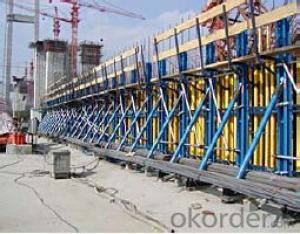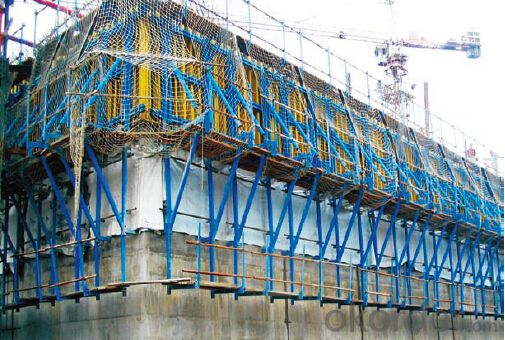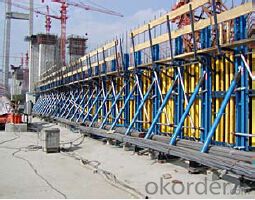Single-Side Climbing Bracket for formwork and scaffolding system
- Loading Port:
- Tianjin
- Payment Terms:
- TT OR LC
- Min Order Qty:
- 50 m²
- Supply Capability:
- 1000 m²/month
OKorder Service Pledge
OKorder Financial Service
You Might Also Like
Single-side Climbing Bracket SCB180:
With CNBM SCB 180 climbing systems, the loads from the fresh concrete pressure are
transferred through the brackets by means of V-strongbacks and compression braces into the
scaffold anchors.
Typical applications for the SCB 180 are dams, locks, cooling towers, pier heads, tunnels, and
bank vaults.
The formwork is simply tilted backwards when striking takes place. The 1.80 m wide bracket
requires only a minimum of space.
Characteristics:
◆ Economical and safe anchoring
The M30/D20 climbing cones have been designed especially for single-sided concreting using
SCB180 in dam construction, and to allow the transfer of high tensile and shear forces into the still
fresh, unreinforced concrete. Without wall-through tie-rods, finished concrete is perfect.
◆ Stable and cost-effective for high loads
generous bracket spacings allow large-area formwork units with optimal utilization of the bearing
capacity. This leads to extremely economical solutions.
◆ Simple and flexible planning
With SCB180 single-sided climbing formwork, circular structures can also be concreted without
undergoing any large planning process. Even use on inclined walls is feasible without any special
measures because additional concrete loads or lifting forces can be safely transferred into the
structure.
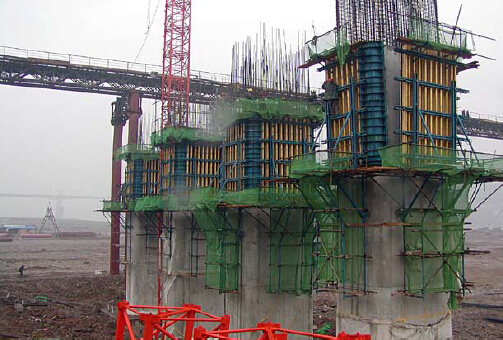
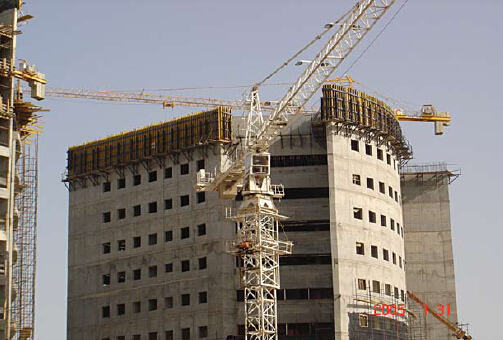
- Q: What are the common design considerations for steel formwork systems?
- There are several common design considerations for steel formwork systems that should be taken into account to ensure the successful construction of a project. Firstly, the load-bearing capacity of the steel formwork system is a crucial consideration. The formwork must be able to safely support the weight of the concrete being poured and any additional loads such as workers or equipment. This requires careful calculation and analysis to determine the appropriate thickness and reinforcement of the steel formwork. Secondly, the formwork system should be designed to provide adequate stability and resistance against lateral forces. This is particularly important in high-rise or complex structures where wind or seismic loads may be significant. The design should incorporate bracing and anchorage systems to ensure the formwork remains stable during construction. Another important consideration is the ease of assembly and disassembly of the steel formwork system. The design should allow for efficient installation and removal, minimizing labor and time requirements. This often involves the use of modular components and standardized connections that can be easily assembled and dismantled. Additionally, the formwork system should be designed to accommodate any necessary adjustments or modifications. Construction projects often require changes or adaptations during the construction process, and the formwork should be flexible enough to accommodate these changes without compromising structural integrity. Furthermore, safety considerations play a vital role in the design of steel formwork systems. The formwork should be designed to provide a safe working environment for construction workers, with features such as handrails, access platforms, and non-slip surfaces. Additionally, the design should consider potential hazards, such as sharp edges or protruding elements, and incorporate appropriate safety measures to mitigate these risks. Lastly, the durability and longevity of the steel formwork system should be taken into account. It should be designed to withstand the harsh conditions of construction, including exposure to weather, chemicals, and repeated use. This may involve the use of corrosion-resistant materials or protective coatings to ensure the longevity and performance of the formwork system. In conclusion, the common design considerations for steel formwork systems include load-bearing capacity, stability against lateral forces, ease of assembly and disassembly, adaptability to changes, safety features, and durability. By carefully considering these factors, engineers can design a steel formwork system that meets the specific requirements of a construction project and ensures its successful execution.
- Q: How does steel formwork handle different concrete pouring techniques?
- Steel formwork offers versatility and durability, making it an excellent option for various concrete pouring techniques. It possesses the strength and rigidity necessary to withstand the pressures exerted by different pouring methods, ensuring a stable and secure structure. One commonly used technique is gravity pouring, where concrete is poured into the formwork from above and allowed to flow downwards under its own weight. Steel formwork is highly suitable for this method as it effectively contains the concrete, preventing any leakage or spillage. The formwork's tight joints and sturdy panels ensure that the concrete remains in place and is evenly distributed throughout. Another technique is pumping, which involves using specialized equipment to pump concrete into the formwork. Steel formwork can handle this technique effectively, as it can withstand the force and pressure exerted during the pumping process. Its robust construction and reinforced edges provide the necessary support to contain the concrete and prevent any deformation or leakage. Steel formwork is also compatible with slip-forming, a technique that involves continuously pouring concrete into a moving formwork system. This method requires a formwork system that can be easily adjusted and adapted to changing shapes and heights. Steel formwork's modular design allows for quick and efficient adjustments, making it suitable for slip-forming applications. Additionally, its strength and stability ensure that the formwork remains intact during the continuous pouring process. In conclusion, steel formwork is a reliable choice for handling different concrete pouring techniques. Its strength, rigidity, and adaptability make it capable of withstanding the pressures and forces exerted by gravity pouring, pumping, and slip-forming methods. With steel formwork, builders and contractors can confidently execute various concrete pouring techniques, resulting in high-quality and structurally sound construction projects.
- Q: What is the maximum load that steel formwork can support?
- The maximum load that steel formwork can support varies depending on factors such as the specific design, quality of steel used, and the support system in place. It is crucial to consult the manufacturer's specifications and engineering calculations to determine the safe maximum load for a particular steel formwork.
- Q: What are the different types of formwork corner solutions used in steel formwork?
- There are several different types of formwork corner solutions used in steel formwork, each with its own advantages and suitability for different construction projects. Some of the common types include: 1. Internal Corner Solutions: These are used to create 90-degree internal corners in the formwork. They often consist of corner brackets or angle brackets that are attached to the steel formwork panels. These brackets provide stability and support to the formwork system, ensuring that the concrete is poured accurately and without any leakage. 2. External Corner Solutions: These are used to create 90-degree external corners in the formwork. They typically consist of corner brackets or external corner connectors that are attached to the steel formwork panels. These connectors provide stability and reinforcement to the formwork system, ensuring that the concrete is poured accurately and without any leakage. 3. Adjustable Corner Solutions: These are used to create corners of varying angles in the formwork system. They often consist of adjustable corner brackets or connectors that can be adjusted to the desired angle. These solutions are particularly useful when constructing structures with irregular or non-standard angles. 4. Corner Chamfer Solutions: These are used to create chamfered corners in the formwork system. They typically consist of chamfer strips or corner chamfer connectors that are attached to the steel formwork panels. These solutions allow for the creation of beveled edges in the concrete, giving a more aesthetically pleasing finish to the structure. 5. Corner Formwork Solutions: These are specially designed formwork systems that are specifically used for creating corners in the construction project. They often consist of pre-fabricated corner panels or corner formwork molds that can be easily assembled on-site. These solutions provide a quick and efficient way to create corners in the formwork system, saving time and labor. Overall, the choice of formwork corner solution depends on the specific requirements of the construction project, including the desired corner angle, the complexity of the structure, and the desired finish. It is important to carefully evaluate the different options and select the most suitable solution to ensure a successful and efficient construction process.
- Q: What are the different types of formwork bracing used with steel formwork?
- Steel formwork can be supported and stabilized using various types of bracing. These include: 1. Horizontal Bracing: Installed between vertical supports, this bracing provides stability and prevents lateral movement or deformation of the formwork. 2. Diagonal Bracing: By connecting vertical supports diagonally, this bracing adds stability, evenly distributes the load, and prevents twisting or buckling of the formwork. 3. Vertical Bracing: Installed between horizontal supports, this bracing supports the vertical members of the formwork system and prevents vertical movement or deformation. 4. Cross Bracing: This bracing combines horizontal and diagonal support, providing both lateral and diagonal stability. It is commonly used in larger structures or when increased stability is required. 5. Tie Rods: These rods connect the formwork panels and offer additional support. They are placed at regular intervals along the formwork and tightened to ensure that the formwork remains in place during concrete pouring. The selection of formwork bracing depends on project-specific requirements, such as the size and complexity of the structure, as well as the load-bearing capacity of the formwork system. It is crucial to design and install the bracing carefully to ensure the safety and stability of the formwork during construction.
- Q: Are there any specific safety measures to be followed during steel formwork installation?
- Yes, there are specific safety measures that should be followed during steel formwork installation. Here are some of the most important ones: 1. Personal Protective Equipment (PPE): All workers involved in the installation of steel formwork should wear appropriate PPE, including safety helmets, gloves, safety glasses, and steel-toed boots. This will help protect against potential head injuries, hand injuries, eye injuries, and foot injuries. 2. Training and Competency: Workers should be properly trained and competent in the installation of steel formwork. They should have a good understanding of the equipment being used, the proper installation techniques, and the potential hazards associated with the work. 3. Equipment Inspection: Before starting the installation process, all formwork equipment, including steel frames, braces, and connectors, should be inspected for any damage or defects. Any damaged or defective equipment should be taken out of service and replaced. 4. Secure and Stable Platform: A secure and stable platform should be established for workers to safely install the steel formwork. This may involve the use of scaffolding or other supporting structures. The platform should be properly erected and inspected for stability before work begins. 5. Fall Protection: Fall protection measures should be in place to prevent workers from falling while installing the steel formwork. This may include the use of guardrails, safety harnesses, and safety nets. Workers should be properly trained in the use of fall protection equipment and procedures. 6. Lifting and Handling: Proper lifting and handling techniques should be used when moving and positioning steel formwork. Workers should avoid overexertion and use mechanical aids, such as cranes or hoists, when necessary. Additionally, workers should be mindful of their posture and avoid awkward or strenuous lifting positions. 7. Communication and Coordination: Effective communication and coordination among workers is crucial during steel formwork installation. This includes clear instructions, proper signaling, and a designated person in charge of coordinating the work. This will help prevent accidents and ensure a smooth and safe installation process. By following these safety measures, the risk of accidents and injuries during steel formwork installation can be significantly reduced, creating a safer working environment for all involved.
- Q: What are the typical lead times for manufacturing and delivering steel formwork?
- Various factors can cause the typical lead times for manufacturing and delivering steel formwork to vary. Generally, these lead times can range from a few weeks to a few months. The manufacturing lead time for steel formwork depends on factors such as the complexity of the design, the required quantity, and the manufacturer's capacity. If the design is simple and the manufacturer has available capacity, the lead time can be relatively short, around 2-4 weeks. However, if the design is more intricate or if the manufacturer is facing high demand or limited capacity, the lead time can extend to 6-8 weeks or even longer. Once the steel formwork is manufactured, the delivery lead time will depend on the distance between the manufacturing facility and the project site, as well as the chosen mode of transportation. Local or regional deliveries can generally be completed within a few days to a week, while international shipments may take longer due to customs clearance and additional logistics. It is important to consider these factors when estimating the overall lead time for steel formwork delivery. It is important to note that these lead times are only general estimates, and actual lead times can vary significantly depending on the specific circumstances. Therefore, it is recommended to directly consult with the manufacturer or supplier to obtain accurate lead time information for a particular steel formwork project.
- Q: How does steel formwork handle different concrete mix designs?
- Steel formwork is highly versatile and can easily handle different concrete mix designs. Its strength and durability allow it to withstand the pressure exerted by different concrete compositions. Additionally, steel formwork provides a smooth and even surface, ensuring that the concrete is properly shaped and cured. Its adaptability makes it suitable for a wide range of concrete mix designs, enabling construction projects to effectively accommodate various specifications and requirements.
- Q: How does steel formwork handle different concrete jointing techniques?
- Steel formwork is a versatile and robust system that can easily handle different concrete jointing techniques. Whether it is traditional jointing methods or modern techniques, steel formwork provides the necessary structural support and flexibility to accommodate various jointing requirements. For traditional jointing techniques such as construction or control joints, steel formwork allows for precise and clean cuts to be made in the concrete. The formwork acts as a guide, ensuring that the joints are accurately placed and aligned. The steel formwork's rigid structure provides stability during the concrete pouring process, preventing any misalignment or movement that could affect the jointing. In the case of modern jointing techniques like expansion joints, steel formwork can be adjusted to accommodate the desired joint spacing and movement. The formwork can be designed with additional features such as flexible connections or removable sections, allowing for the required expansion or contraction of the concrete. This ensures that the joints remain intact and functional, even when the concrete undergoes temperature or moisture-related changes. Additionally, steel formwork offers the advantage of reusable panels and components. This means that the formwork can be easily disassembled and reassembled to accommodate different jointing techniques or even reused for future projects. This flexibility and adaptability make steel formwork a cost-effective and efficient choice for handling various concrete jointing techniques. In conclusion, steel formwork is well-suited to handle different concrete jointing techniques. Its strength, stability, and adjustability allow for precise and accurate joint placement, while its reusability makes it a practical choice for various projects.
- Q: How does steel formwork affect the overall construction site aesthetics?
- Steel formwork can greatly enhance the overall aesthetics of a construction site. Its sleek and modern appearance gives a professional look to the project, creating a sense of organization and efficiency. Steel formwork's clean lines and smooth finishes provide a visually pleasing backdrop for the construction process, improving the overall visual appeal of the site. Additionally, its durability and ability to create precise and intricate designs contribute to a more refined and sophisticated aesthetic outcome.
Send your message to us
Single-Side Climbing Bracket for formwork and scaffolding system
- Loading Port:
- Tianjin
- Payment Terms:
- TT OR LC
- Min Order Qty:
- 50 m²
- Supply Capability:
- 1000 m²/month
OKorder Service Pledge
OKorder Financial Service
Similar products
Hot products
Hot Searches

